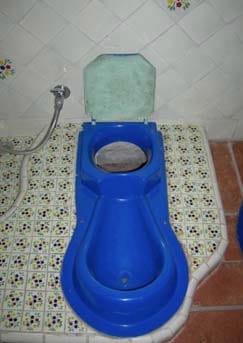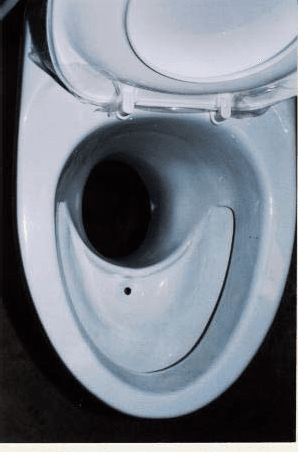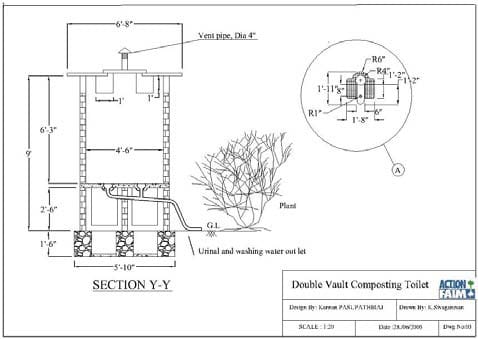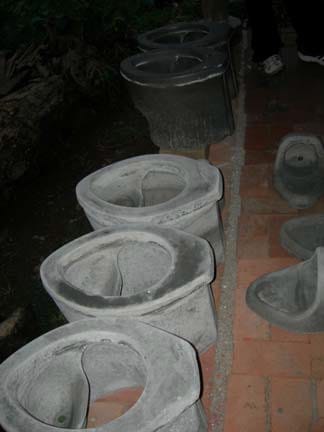This Technical Brief looks at the criteria for selecting Urine Diversion (UD) and Composting Toilets options in an emergency setting, including the construction, operation and maintenance of such units.
Ecological Sanitation or Sustainable Sanitation?
The approach of Ecological Sanitation (Ecosan) in emergency settings breaks with conventional excreta disposal options such as pit latrines or pour-flush toilets. Traditionally, Ecosan systems re-use both faeces and urine, turning them into either a soil conditioner or a fertilizer. This not only benefits peoples’ health through safe excreta disposal and by reducing environmental contamination, but also implies re-using the by-products for some form of agricultural activity.
In an emergency setting, the choice of ecosan options is very often driven by factors other than the re-use of all or part of the by-products. Ecosan toilets are very often better suited to rocky ground or areas with high water tables, making them more resistant to cyclic flooding for instance. Unlike pit latrines, they can be used for many years, making them a much more attractive option in terms of sustainability. They do however require more careful operation and maintenance than a pit latrine or a pour-flush toilet. Saving water may be another key factor in selecting ecosan units.
Key Concepts in Ecological Sanitation
Ecological latrines can be broadly divided into two main categories:
- Dehydrating urine diversion (UD) toilets
- Composting toilets
Urine diversion(UD) toilets
These are commonly used to separate human urine at source before it mixes with the faeces. This means urine and faeces can be handled separately and in a specific manner. Separation is achieved through specially designed toilets and urinals, UD toilets, which are connected to a collection system and then to either a storage container or a soak away. Urine diversion toilets come in many forms; seated pedestals; squatting plates; and separate urinals for men, making them easy to adapt to local cultural norms. One advantage of separating urine from faeces is to reduce potential odours as well as prolonging latrine life.
Urine separation toilets are commonly used in conjunction with an alternating double vault system, which is used to store and dry the faeces over a specified period. Normally, it is recommended to store faeces for a minimum of 12-months in one vault before emptying. Adding a desiccating material such as ash or sawdust will accelerate the faeces drying process. Typically, in a well- managed ecosan unit, storage times of greater than 3- months will reduce many pathogens to safe levels, in particular those responsible for Ameobiasis, Giardiasis, Hepatitis A, Hookworm, Whipworm, Threadworm, Rotavirus, Cholera, Escherichia coli, and Typhoid amongst others. Ascaris is more persistent though, and may require retention times of 12-months or more.


Composting toilets
The simplest and best-known composting toilet is the “Arborloo”. This toilet uses an unlined shallow pit (1 – 1.5 metre deep), fitted with a ring beam, slab and portable superstructure. As the pit is used, soil, ash and leaves can be added to the pit to keep fresh faeces covered. When the pit is nearly full, a new pit is dug close by, and the ring beam, slab and superstructure are moved to the new site. The old pit is then covered with soil, allowing contents to compost down. When fully composted, a tree (typically a fruit tree) is planted. The advantage of the “Arborloo” system is that latrines are typically low-cost, and can be built from locally available materials. The “Arborloo” also avoids the need to handle the “compost”, making it a very simple and safe way to recycle nutrients

The Use of Arborloos, Grande Saline, Haiti
The latrine uses a concrete slab. This was the most expensive part, and is designed to be moved from the pit in use to the newly dug one. The slab, frame and roof were donations, due to cost, and can be expected to be used for many years.
Construction– 4 Steps
- The beneficiaries dug their pits (90 cm diameter & 2 m deep), with a community supervisor providing technical support as the communities were digging.

- A local contractor, from the community, manufactured reinforced slabs (120x120cm) near the pits. A 30 x 40 cm masonry rim was built to prevent cave ins and surface water inflows. The rim is made of stones and ‘poor’ concrete, but capable of supporting the slab’s weight. The stones and wooden frame can be reused for a new latrine at a later date.
- Beneficiaries were given responsibility to complete the superstructure using locally available materials. Many people chose mud walls (similar to local houses), but woven palm tree leaves were also used. Trained community volunteers supervised the work.
- When completed, the contractor installed the metallic roofing and finalised technical aspects of the work.
Maintenance and Handwashing
People were trained to use latrines properly and to wash hands after use. A kit containing soap, brush, bucket and baby potty and a small shovel were distributed to the latrine users.
Sustainability
The design is adapted to the local context:
- The latrine is above ground level, helping to stop surface water entering the pit, and can resist floods < 15 cm deep.
- All materials are re-usable. The slab can be moved to another site when the pit is full, or in case of severe flooding. The rim masonry can be re-used. The wooden frame and the metallic roof can also be re-used in a new latrine.
- People understood that even with mud, stones and local material it is possible to construct a simple latrine. Neighbours or people from nearby communities, who have the means, can easily reproduce the model.
Lesson learned
The post-flood intervention promoted a simple solution that people can easily replicate, resulting in increased latrine coverage to 80% of the target population. The ‘’Arborloo’’ design requires only local material and emphasises the message “anybody in the community can build his/her own latrine”. The design is simple, affordable, easy to maintain and doesn’t need to be emptied when full.
Criteria for Selection
In an emergency setting, a number of factors must be fully considered before deciding to introduce either UD toilets or composting toilets, and it is recommended to adopt a programme process, based on solid assessments of the situation (Excreta Disposal in Emergencies Manual). Consultation with the affected community is an essential part of this assessment process. However, a number of parameters, specific to the choice of either UD or composting technology should also be considered. These include:
- The physical constraints (rocky ground, sandy soils, high water table, flood plain, etc.) existing in the target community, which may make ecosan an attractive option?
- Fully understanding the communities preferences regarding excreta disposal practices and facilities
- Understanding existing local knowledge and experience in ecosan and local organisations involved in promoting ecosan
- Do the community intend to re-use any of the by-products and are there any strongly held beliefs or taboos on handling urine or faeces
- Being aware of the availability and cost of UD hardware and the quality of that hardware
- The availability of space, particularly for the Arborloo system
- Understanding the needs of men, women, children and those with special needs
Using UD toilets in a 1st phase response
The priority of 1st phase options is the speed of response, and it is essential that 1st phase technologies to contain excreta can be installed quickly. Normally, UD technology is associated with 2nd phase responses, particularly in flood prone areas. However, novel solutions to rapid on- set floods have been tried and tested in Latin America.
Rio Beni Floods, Bolivia
In March 2008, an estimated 20,000 people from areas surrounding Trinidad (Dept. Beni) moved onto flood protection embankments surrounding the city. Shelters were set-up; with water & sanitation issues quickly became problematic. The embankments were crowded and open defecation was rife, the ground was waterlogged, and shelters occupied all of the empty space. Most importantly, there was no elevation, so impossible to dig down.
The units installed on the embankments were set up close to those displaced, and came from a local authority contingency stock (from 2007 floods).

The UD design itself is innovative, as it can be set up quickly, and separates urine from faeces. Urine is drained to a container, while the faeces are collected in a 200-litre drum lined with a bin liner. The local authorities are then responsible for collecting the faeces filled bags on a daily basis. Bags are then disposed of at a landfill after collection by truck. Separating the faeces from the urine facilitates the handling of the two human waste streams. The collection & disposal system does work, but experiences from Bolivia highlighted the local authorities need to provide a reliable O&M service. The awareness of users also needs to be raised, particularly in relation to good hygienic practices.

In Bolivia, many people use toilet paper and throw used paper into a bin. If there’s no bin, people still throw the paper next to the toilet anyway. Quickly, this becomes a problem in a communal toilet. Encouraging people to throw their used paper into the latrine would be one solution to improve toilet cleanliness.
Construction of UD toilets in 2nd phase of a response
The easiest way to construct an UD toilet is to build it above ground. This makes it easier to both contain and to remove contents when desiccated. The impermeable bottom of chamber prevents contamination of the soil and ground water. Commonly, above ground vault structures have twin chambers, with one chamber being used while the faeces in the other chamber break down into dry compost. Enough space must be left at the top of the chambers in order to install the hose or piping required to collect the urine, and to take it from the urine separation bowl to either a storage container or a specially designed urine soak away.
Careful attention must also be paid to the ergonomics and design of the superstructure, as the inappropriate selection of materials may result in a latrine being overly hot or cold, and being seen climbing up steps to enter the latrine may discourage use. Good latrine siting is therefore a prerequisite to successful implementation.
Community Dialogue
The requirements of men, women, young people, children, those with special needs and disabilities in relation to Eco San toilet will be different. In consulting with the community it will be important the men and women are both consulted and their needs and requirements identified. For example, women having monthly bleeding may safely use ecological toilets.
Designing a Twin-vault UD Toilet
Chambers:
In a 12-month period, an adult will produce 500 litres of urine & 50 litres of faeces. The chamber size must be adjusted for the planned number of users. Typically, for a household of 5 people, this will require two chambers of 0.40 m3 minimum. This will result in a chamber of 0.9m high x 0.7m deep x 0.6 wide, giving a usable volume of 0.40 m3. Two chambers are required for a double vault unit. The larger the volume, the longer the faeces retention time, resulting in better pathogen die-off. However, larger volumes will result in higher costs due to increased quantities of materials and higher labour costs.

Key steps in UD Toilet Construction
For the construction of good quality UD toilets, the following steps must to be adhered to, particularly in the 2nd phase of an emergency:
- A good design needs to be selected which meets the needs and aspirations of the affected communities. The design must be adapted to follow cultural norms in relation to safe excreta disposal.
- Once an adequate design has been decided on, it will be necessary to produce the engineering drawings and the BOQs for that particular design.
- A decision needs to be made as to whether the urine will be collected and stored, or whether it will be collected and drained away to a soak-away? Opportunities for productive use of by products will need to be explored.
- The UD pedestal or squatting plate choice will depend on cultural appropriateness, quality and cost. The choice of the correct hardware will be key to ensuring the units are used and maintained.
- Suppliers for the necessary UD hardware and the required technical expertise for the construction of the units must be identified. Where appropriate, the relevant supplies and technical expertise may need to be contracted out (see Oxfam TBN no. XX).
- Unit construction must be supervised closely, to ensure the unit performs in a safe and user-friendly manner. In particular, care must be given to ensure the chambers are hermetic and that the door sealing the chambers fit well and are easy to operate.
- The choice of superstructure materials will impact heavily on subsequent usage and acceptability. The structure should promote safety, dignity and comfort for the user. Windows, and painting with bright colours will make the interior bright and friendly, hence more likely to be used.
- The provision of a ventilation pipe will reduce smells and may be useful in preventing flies from entering the unit. This will however raise the overall cost.
- Finally, a clear plan to allow both the participation of the target community and to subsequently train and raise their awareness about the correct use and maintenance of UD units.

Urine Disposal through infiltration:
In the event that a decision has been taken not to reuse the urine for agricultural purposes, then it will be necessary to select a suitable safe means of disposal. Typically, urine will be directly drained to an infiltration bed or seepage trench. Plants like banana, papaya or other fruit trees can be planted in and around the bed. There are several options for the disposal of urine at house hold level including:
For high water tables
- Evaporation Bed
- French Drainage
For water tables below 2 m
- Seepage bed
- Seepage Trench
POSSIBLE CASE STUDY 2nd PHASE RESPONSE – DOMINICAN REPUBLIC
OR FROM ZIMBABWE
Operation and Maintenance of UD Toilets
Toilets constructed under the Eco san approach need the user help to separate urine from faeces. Therefore the user has to be aware to urinate only in the front of the toilet pan or closet while defecating only in the back part.
- After defecation, a small amount of water should be added to clean the urine bowl, while the fresh faeces should be covered with soil, sawdust, ash or another desiccating material.
- The toilet pan or squat plate should be covered to prevent flies from entering into the unit.
- When urine collection and storage is practiced, the urine storage container should be emptied on a regular basis. Correct handling and storage of the urine is critical for agricultural purposes.
- A badly smelling toilet could be a sign that either urine is mixing with faeces or that not enough desiccating material is being used.
- Organic materials such as toilet paper can be added to the faeces. None organic waste should be separated and kept outside the toilet, being disposed of separately.
- When the chambers are emptied, it is necessary to handle the contents with care and attention. Safety equipment such as boots and gloves should be used.
Using faeces and urine from an Ecosan Toilet
Since ancient history, human urine and excreta have been used in agriculture to improve soil fertility, particularly in countries like China, where the use of “night soil” has generated trade in human by-products such as urine and faeces.
On average, an adult produces around 500 litres of urine and 50 litres of faeces in a year, enough nutrients to produce around 250 kg of cereal.
| Fertilizer | Urine (kg/500 l) | Faeces (kg/ 50 l) | Total (kg) | Requirement for 250kg cereal |
| Nitrogen | 5.6kg | 0.09kg | 5.7kg | 5.6kg |
| Phosphorus | 0.4kg | 0.19kg | 0.6kg | 0.7kg |
| Potassium | 1.0kg | 0.17kg | 1.2kg | 1.2kg |
The majority of nutrients are contained in the urine, while the vast majority of the pathogens are in the faeces. The quantity of nutrients contained in by- products may vary according to geographical location.
Urine is normally free from pathogens, but can become contaminated when mixed. Urine when collected from different households should be stored for between one to six months for hygiene reasons. However, when households use their own urine, there is no need for storage prior to application. In both cases, the last application should take place at least one month before harvesting. It can be applied pure or diluted, and to avoid smells, burns to foliage and ammonia loss, it should be applied close to the soil and incorporated as quickly as possible.
The faecal part of the by products must always be sanitized before use as a fertiliser. The faeces, although having a lower nutrient content, is high in organic matter, phosphorus, aids water retention and is also a good soil improver. Sanitized faeces should be applied prior to planting or sowing, as the high phosphorus content is good for young plants. The decomposed faeces needs to be fully mixed in and covered.
Post-latrine handling
Independently of the latrine model used, faeces from all ecosan toilets (with the exception of Arborloo) will need to be removed from the unit and applied to the crops. How this is done will have a significant impact on the risks to people undertaking this. The removal and application process involves three areas of risk:
- Those responsible for emptying the pit and applying faeces to the land come into direct contact;
- Children and adults walk, work or play in the area where faeces is deposited or applied to land and poor hygiene practices lead to contamination and infection; and
- Contamination of crops, which is particularly important for crops that may not be cooked before eating, such as tomatoes or lettuce.
The risk of contamination to members of the community depends on how the faeces being removed are applied to crops, as well as the amount of time people from the community spend on that land. When faeces are deposited near people’s homes, or on land where people often congregate, the risk of contamination is increased.
A high risk of contamination occurs if the contents are spread by hand to the land and used as a top dressing. Exposed helminth eggs and pathogens will be a health risk to anybody walking on the land, although this risk will diminish with time as pathogen die-off is accelerated through the effects of sunlight and desiccation.
- If excreta or excreta-derived products are applied to the field before planting crops:
- People removing faeces should be adequately protected during the process;
- The faeces should be placed in trenches and covered with at least 25cm of soil; and
- Root crops should not be planted directly over the trenches.
Selecting UD hardware
Toilets and urinals are typically constructed of ceramic, concrete, fibreglass or plastic. Drainpipes and tubing are normally made of durable plastics, such as PVC or polyethylene. Storage containers for urine are typically made from plastic. Components made of metal should be avoided wherever possible as urine can cause corrosion.
Good quality toilet hardware can be procured/obtained from a number of sources, including a range of producers located in Sweden, Philippines, Mexico, El Salvador and South Africa. Alternatively, products can be manufactured locally, using appropriate mass production techniques including concrete and fibreglass moulds. In the event of local manufacture, considerable care must be given to controlling production quality, and ensuring that the UD toilet hardware is of the highest quality. I.e. concrete toilet pedestals may be covered with a high quality enamel paint or fibreglass layer to produce a smooth, non-porous surface that is easy to clean.

Choosing hardware that meets the needs and cultural preferences (i.e. seated, squatting, wet or dry anal cleansing) of users is key in terms of technology acceptance.

The adoption of urinals for in UD toilets for men, who prefer to stand when urinating, is one way of accommodating a particular physiological difference, and hence improving the performance and effectiveness of UD toilets.
Sustainable Sanitation & Ecosan Networks
Oxfam has collected a number of resources on sustainable sanitation and ecological sanitation, and these can be found on the Sanitation in Emergencies web page:
Link to Oxfam resource site
http://oxfam.org.uk/resources/learning/humanitarian/ecosan.html
There are a number of networks exist globally that promote the use of sustainable sanitation and ecosan technology. Key organisations include:
In English:
Stockholm Environment Institute (EcoSanRes)
http://www.ecosanres.org/
GTZ (German Federal Government)
http://www.gtz.de/en/themen/umwelt- infrastruktur/wasser/8524.htm
Sustainable Sanitation Alliance (SuSanA)
http://www.susana.org/ WASTE Netherlands http://www.ecosan.nl/page/447
IWA Specialist Group “Resources oriented Sanitation”
http://www.ecosan.org/
Sustainable, Organic, Integrated Livelihoods (SOIL) http://www.oursoil.org/ecologicalsanitation.php Sustainable Settlement in Southern Africa
http://www.sustainablesettlement.co.za/howto/urinediv/what.html
EcoSan Philippines
http://www.ecosan.ph/index.php?option=com_frontpage&Itemi d=1
In French:
Centre Régional pour l’Eau Potable et l’Assainissement à faible coût (CREPA)
http://www.reseaucrepa.org/page/1306
In Spanish:
Sarar Transformación SC
http://www.sarar-t.org/portal/index.php
Further information
Excreta Disposal in Emergencies, a field manual – Harvey, P. (an Inter-agency publication).
Toilets That Make Compost – EcoSanRes Paper http://www.ecosanres.org/pdf_files/ESR-factsheet-13.pdf
Ecological Sanitation – Authors: Smet, J. and Sugden, S., April 2006. WELL FACTSHEET http://www.lboro.ac.uk/well/resources/fact-sheets/fact-sheets- htm/Ecological%20sanitation.htm
Guidelines on the Use of Urine and Faeces in Crop Production – EcoSanRes Paper http://www.ecosanres.org/pdf_files/ESR-factsheet-06.pdf
Should ecological sanitation carry a health warning? Assessing the health risks of ecological latrin es. Scott, R., (2006) WELL Briefing note 27. WELL, Loughborough University. http://www.lboro.ac.uk/well/resources/Publications/Briefing%20Notes/BN27%20Ecological%20sanitation.htm
